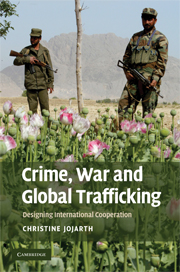Book contents
- Frontmatter
- Contents
- List of figures
- List of tables
- List of abbreviations
- Preface and acknowledgments
- 1 Introduction
- 2 The concept of legalization
- 3 Problem constellation
- 4 Narcotic drugs: UN Convention against Illicit Traffic in Narcotic Drugs and Psychotropic Substances
- 5 Money laundering: the Financial Action Task Force and its Forty Recommendations
- 6 Conflict diamonds: the Kimberley Process Certification Scheme
- 7 Small arms and light weapons: the United Nations Program of Action
- 8 Conclusion
- References
- Index
6 - Conflict diamonds: the Kimberley Process Certification Scheme
Published online by Cambridge University Press: 02 July 2009
- Frontmatter
- Contents
- List of figures
- List of tables
- List of abbreviations
- Preface and acknowledgments
- 1 Introduction
- 2 The concept of legalization
- 3 Problem constellation
- 4 Narcotic drugs: UN Convention against Illicit Traffic in Narcotic Drugs and Psychotropic Substances
- 5 Money laundering: the Financial Action Task Force and its Forty Recommendations
- 6 Conflict diamonds: the Kimberley Process Certification Scheme
- 7 Small arms and light weapons: the United Nations Program of Action
- 8 Conclusion
- References
- Index
Summary
“Diamonds are a girl's best friend,” Marilyn Monroe famously sang in the 1953 movie Gentlemen Prefer Blondes. Half a century later, the phrase took on a decidedly less romantic twist, as diamonds became a rebel's best friend, helping to fund bloody conflicts in western and central Africa. In response to these conflicts, officials of interested governments, together with non-governmental organizations and industry representatives met in the old South African diamond city Kimberley in May 2000 to hammer out an internationally coordinated effort to prevent rebels from turning diamonds into arms and payment for fighters. With great speed and creativity – at least in comparison with most other international initiatives – this diverse set of actors devised the so-called Kimberley Process Certification Scheme, which formulates a minimum set of trade control measures aimed at denying so-called “blood diamonds” or “conflict diamonds” access to international markets.
This chapter examines whether the design of this scheme matches the particularities of the illicit trade in these tarnished stones. In contrast to the paradoxical problem constellation found in the previous chapter on money laundering, I will show that in this case all three problem attributes are of the same moderate degree, thus unanimously pointing toward a design solution in the mid-range of the soft–hard law spectrum. As I will argue below, the actual design adopted by the instigators of the Kimberley Process does indeed match this expectation. Like the FATF's Forty Recommendations, the Kimberley Process represents an international institution with a moderate degree of legalization.
- Type
- Chapter
- Information
- Crime, War, and Global TraffickingDesigning International Cooperation, pp. 181 - 220Publisher: Cambridge University PressPrint publication year: 2009
- 1
- Cited by



